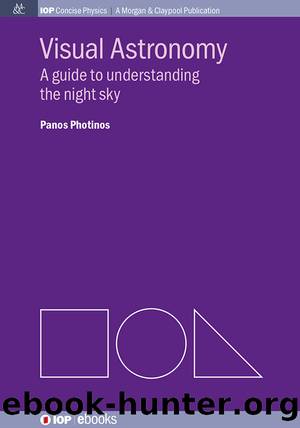Visual Astronomy: A guide to understanding the night sky by Panos Photinos

Author:Panos Photinos
Language: eng
Format: epub
ISBN: 9781627054812
Publisher: IOP Publishing
Published: 2015-03-21T00:00:00+00:00
The gas or ion tail is straight, and consists mainly of water, carbon monoxide (CO) and cyanogen (CN). Under the influence of the intense solar radiation the neutral molecules in the gas may become ionized, i.e. electrically charged (hence the ion tail). The ions can emit light by recombining with electrical charges to become neutral again. The light emitted in this process by the carbon monoxide (COâ) ion usually gives the bluish color to the ion tail as seen in telescope images. The electrical charges of the ion tail interact with the electrical charges in the solar wind, giving the ion tail its straight shape. Telescopic observations of the ion tail reveal kinks, disruptions and, at times, separation of the tail. These features reflect the dynamic interaction of the charges in the ion tail with the solar wind. The density of the material around the icy nucleus is much lower than the Earthâs atmosphere. Therefore, it is not surprising that stars can be visible through the head and tails of the comet, as shown in figure 6.2.
Figure 6.2. Comet West was discovered in photographs by Richard West on 10 August 1975. It reached peak brightness in March 1976. During its peak brightness, observers reported that it was bright enough to study during full daylight. The comet has an estimated orbital period of 558 000 years. Note that stars are visible through the dust tail. Credit: J Linder/ESO, http://www.eso.org/public/images/c-west-1976-ps/.
Download
This site does not store any files on its server. We only index and link to content provided by other sites. Please contact the content providers to delete copyright contents if any and email us, we'll remove relevant links or contents immediately.
Sapiens: A Brief History of Humankind by Yuval Noah Harari(14163)
Sapiens by Yuval Noah Harari(5263)
Pale Blue Dot by Carl Sagan(4856)
Homo Deus: A Brief History of Tomorrow by Yuval Noah Harari(4776)
Livewired by David Eagleman(3623)
Origin Story: A Big History of Everything by David Christian(3589)
Brief Answers to the Big Questions by Stephen Hawking(3319)
Inferior by Angela Saini(3209)
Origin Story by David Christian(3117)
The Gene: An Intimate History by Siddhartha Mukherjee(3014)
Signature in the Cell: DNA and the Evidence for Intelligent Design by Stephen C. Meyer(2996)
The Evolution of Beauty by Richard O. Prum(2912)
Aliens by Jim Al-Khalili(2763)
How The Mind Works by Steven Pinker(2695)
A Short History of Nearly Everything by Bryson Bill(2578)
Sex at Dawn: The Prehistoric Origins of Modern Sexuality by Ryan Christopher(2440)
From Bacteria to Bach and Back by Daniel C. Dennett(2423)
Endless Forms Most Beautiful by Sean B. Carroll(2402)
Who We Are and How We Got Here by David Reich(2375)
